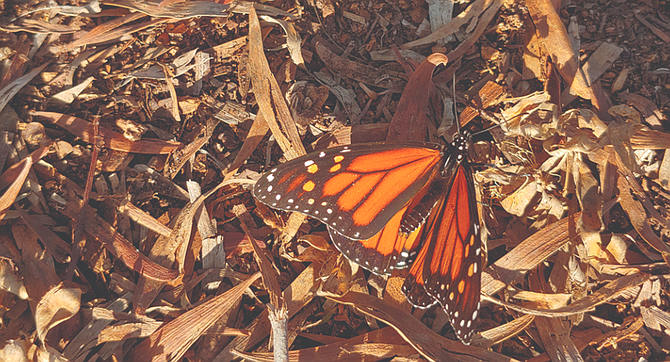 Facebook
Facebook
 X
X
 Instagram
Instagram
 TikTok
TikTok
 Youtube
Youtube

Monarch Butterflies arrive along the California coast this month, migrating from their summer homes in the Sierra Nevada and the Rocky Mountains. Some 25 of the 260 wintering sites on the West Coast lie within San Diego County. The local sites include Presidio Park in San Diego, the UCSD campus, Quail Botanical Gardens in Encinitas, and Hosp Grove in Carlsbad.

Acorn Dropping reaches a crescendo early this month in the Cuyamaca, Laguna, and Palomar mountains. Wiry scrub oaks, massive canyon live oaks, and the golden-leaved black oaks all contribute to the growing collection of acorns littering the ground. Acorn woodpeckers are busy stuffing acorns into the small holes they drill into the bark of pine trees. Beneath the trees, the browns of bracken fern and the reds of poison oak and squaw bush are among the last expressions of autumn color we'll see in the mountains this year.
November’s Full Moon rises like a pale, beige balloon in the east at around 4:20 p.m. — about 25 minutes before sunset — on Wednesday afternoon, November 12. Barring the incursion of overnight low clouds across the coastal strip, San Diegans can witness the same full moon setting over the Pacific Ocean at sunrise the following morning. Some folk names for the November full moon include “snow moon,” “fog moon,” “mourning moon,” “mad moon,” and “moon of storms.”
Atmospheric Ice-Crystal Effects are often observed, starting about this time of year, because of the frequent appearance of high clouds made of tiny bits of ice. The most familiar of these optical effects is the 22˚-radius halo, or ring, around the sun or the moon. Less often seen is a “corona” (a colored disk around the sun or moon — not the same as the solar corona seen during total eclipse); “sundogs” (colored arcs left and right of the sun); the sun pillar (a vertical column of light above the rising or setting sun); and a host of other rare and inconspicuous optical phenomena. All of the optical effects mentioned are a consequence of sunlight or moonlight refracting through or reflecting from the tiny facets of ice crystals in cirrus and other types of high clouds.
The above comes from the Outdoors listings in the Reader compiled by Jerry Schad, author of Afoot & Afield in San Diego County. Schad died in 2011. Planet information from SkyandTelescope.org.


Monarch Butterflies arrive along the California coast this month, migrating from their summer homes in the Sierra Nevada and the Rocky Mountains. Some 25 of the 260 wintering sites on the West Coast lie within San Diego County. The local sites include Presidio Park in San Diego, the UCSD campus, Quail Botanical Gardens in Encinitas, and Hosp Grove in Carlsbad.

Acorn Dropping reaches a crescendo early this month in the Cuyamaca, Laguna, and Palomar mountains. Wiry scrub oaks, massive canyon live oaks, and the golden-leaved black oaks all contribute to the growing collection of acorns littering the ground. Acorn woodpeckers are busy stuffing acorns into the small holes they drill into the bark of pine trees. Beneath the trees, the browns of bracken fern and the reds of poison oak and squaw bush are among the last expressions of autumn color we'll see in the mountains this year.
November’s Full Moon rises like a pale, beige balloon in the east at around 4:20 p.m. — about 25 minutes before sunset — on Wednesday afternoon, November 12. Barring the incursion of overnight low clouds across the coastal strip, San Diegans can witness the same full moon setting over the Pacific Ocean at sunrise the following morning. Some folk names for the November full moon include “snow moon,” “fog moon,” “mourning moon,” “mad moon,” and “moon of storms.”
Atmospheric Ice-Crystal Effects are often observed, starting about this time of year, because of the frequent appearance of high clouds made of tiny bits of ice. The most familiar of these optical effects is the 22˚-radius halo, or ring, around the sun or the moon. Less often seen is a “corona” (a colored disk around the sun or moon — not the same as the solar corona seen during total eclipse); “sundogs” (colored arcs left and right of the sun); the sun pillar (a vertical column of light above the rising or setting sun); and a host of other rare and inconspicuous optical phenomena. All of the optical effects mentioned are a consequence of sunlight or moonlight refracting through or reflecting from the tiny facets of ice crystals in cirrus and other types of high clouds.
The above comes from the Outdoors listings in the Reader compiled by Jerry Schad, author of Afoot & Afield in San Diego County. Schad died in 2011. Planet information from SkyandTelescope.org.
Comments